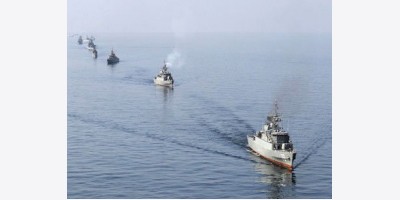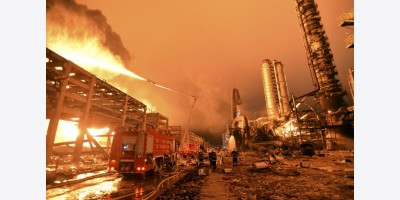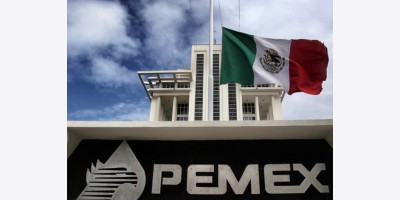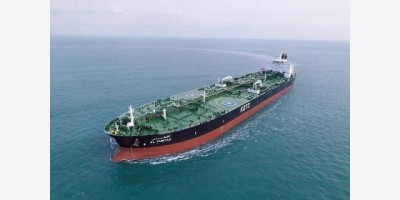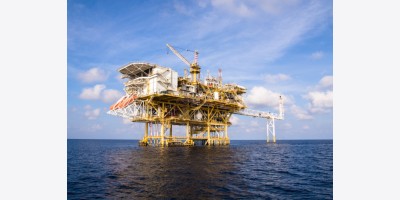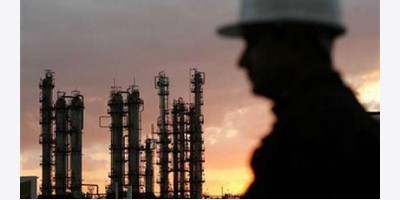Russia’s second-largest oil producer, Lukoil, is aiming to reduce its investment program due to uncertainties on the capital markets, sparked by recent western sanctions against Russia, with the 2015 cuts alone amounting to $2 billion, the company’s officials said Friday.
“My personal position is that we need to pursue a more conservative policy” because it is hard to say what the economic and political situation will be even in the coming two or three months, Lukoil’s vice president Leonid Fedun said during a conference call on the company’s second-quarter results.
“I will offer to my colleagues to reduce the investment program we have now to ensure higher cash [reserves] than that we have now,” Fedun, who is also one of major shareholders in the company, said.
Fedun said the step was necessary because of the current “extreme uncertainty on the market due to the sanctions imposed against Russia, primarily the financial sanctions.” But he also pointed to a fall in the crude price on international markets, especially in the third quarter. “We don’t expect the price will continue to fall further but we don’t see any potential for it to rise, at least through this year,” he said.
Fedun also said that the company was also considering a cut in capex under its three-year program and might delay updating the 10-year program, but did not elaborate. At the same time, senior vice-president for finance Alexander Matytsyn said the company saw the potential to optimize the 2014 program as well because investment in the first half of the year was less than initially envisaged.
Lukoil had felt no impact of the sanctions on its operations so far, but “we feel uncertainty over access to capital,” he told reporters later in the day.
Matytsyn said the company planned to focus on optimizing its upstream investments to achieve greater efficiency. “We need to review our approach and our technologies and focus on most the efficient fields. [We aim] to achieve similar results at lower cost,” he said.
Japan imported 129,990 b/d of crude oil from Iran in July, down 24.4% from 172,047 b/d a year ago and down 31.1% from 188,685 b/d in June, according to preliminary figures released Friday by the Ministry of Economy, Trade and Industry.
Iran was the sixth-largest crude supplier to Japan in July. Japan’s crude imports from Iran averaged 166,902 b/d over January-July, down 8.9% from 183,266 b/d in the same period of 2013, according to Platts calculations based on METI data.
Japan imported a total of 3.10 million b/d of crude in July, down 11.1% year on year, but up 2.9% from June, according to METI data.
Japan refined 3.11 million b/d of crude in July, down 8.8% from 3.41 million b/d a year ago but up 18.7% from 2.62 million b/d in June, when the country’s refinery turnaround season peaked. Japan’s refining capacity fell to 3.95 million b/d as of March 31, down 12% year on year as a result of local refiners’ response to METI regulations.
In July, Japan imported 193,111 b/d of ESPO crude from Russia, double from 95,892 b/d a year earlier and up 66.7% from 115,870 b/d in June. As a result of increases in ESPO crude imports, Japan’s overall crude imports from Russia jumped 44.3% year on year and 11.5% from June to 238,188 b/d in July. Russia was the fourth-largest crude supplier to Japan in July. METI reports monthly oil data in kiloliters, which Platts coverts to b/d.
The percentage of crude imports from the Middle East in July came in at 85%, down from 86.2% a year ago, marking the second consecutive year-on-year decrease in monthly imports.
In July, Saudi Arabia remained Japan’s top supplier, providing 1.06 million b/d, or 34.1% of total crude imports. Japan’s crude imports from Saudi Arabia in July fell 1% year on year but were up 8.7% on June.
Crude imports from Kuwait, the fifth-largest crude supplier in July, dropped 19.7% year on year and slid 15.1% from June to 204,848 b/d. Platts calculates the figures for imports from Kuwait and Saudi Arabia so that each include 50% of the volumes from the Partitioned Neutral Zone shared by the two countries and which METI lists as a separate supply source.
Japan refined 3.11 million b/d of crude in July, down 8.8% from 3.41 million b/d a year ago but up 18.7% from 2.62 million b/d in June, when the country’s refinery turnaround season peaked.
Both METI and the ministry of finance release data on monthly crude imports. Their figures vary because of different methodologies. METI looks at monthly reports from refiners and trading houses, taking into account barrels lifted during the survey period, including condensates.
Russia’s Lukoil expects two tankers with crude from Iraq’s West Qurna 2 field to be sent to Southeast Asian markets within the next two weeks, as crude production at the field hit 330,000 b/d and is set to rise to 400,000 b/d by the end of the year, company vice president Leonid Fedun said Friday.
“The first tanker with crude from West Qurna 2 was reloaded in Sicily. The two other tankers are now being loaded,” Fedun told a conference call on the company’s second-quarter results. “We expect that the two tankers will go to Southeast Asia in the first 10 days of September,” he added.
At a later stage, Lukoil expects to send several tankers a week, in line with an agreed loading program, he said. Fedun also said that crude production at West Qurna 2 have reached 330,000 b/d, up from around 280,000 b/d at the end of July.
Crude production is expected to rise to 400,000 b/d, “or even more”, by the end of the year, he said. Lukoil officials previously indicated that the target of 400,000 b/d could be moved to 2015, but gave no details.
Lukoil launched production at the field in March, within the so-called Early Crude Phase. In August it loaded the first batch of 1 million barrels of crude as part of its right to recover costs related to its investment in the West Qurna 2 field. That was sent to Lukoil’s ISAB refinery on Sicily. Fedun also said that Lukoil expects to recoup in full its investment in the project through 2015.
In June, the Russian major said it had received the right to start the recovery of its investment in the development of the giant field and receive its remuneration fee. The service contract for the development of and production from West Qurna 2 provides for Lukoil, which holds a 75% operatorship stake in the project, to receive cost recovery and a remuneration fee of $1.15/barrel from the field if crude output reaches at least 120,000 b/d during any 90 days within a 120-day period from startup.
On June 11,
Iraq’s oil ministry will submit to a US court a revised claim against the sale of a cargo of Kurdish crude currently off the coast of Texas and still plans to take legal action against any entity that buys crude produced in the Iraqi Kurdistan region.
In a statement posted to its website late Thursday, the ministry said it had been given 10 days by the court to submit its revised claim. “The ministry in the process of preparing its revised request and it will be presented within the required timeframe, it said.
A US judge on Monday rejected the Iraqi central government’s claim to the cargo of 1 million barrels of Kurdish crude aboard the United Kalavrvta, which has been parked in legal limbo in international waters offshore Galveston for nearly a month.
Judge Gray Miller ruled that the US did not have the jurisdiction to block the sale of Kurdish oil, which Baghdad had claimed was illegal under US maritime law.
The Iraq oil ministry said in its statement that the ruling in Texas was “purely procedural” and “very limited.” It said the “theft” of the oil by Kurdistan took place in Iraq, which explained why the court’s jurisdiction was limited.
The ministry also said it remained committed to taking legal action against buyers of Kurdish crude. “The ministry will not hesitate to prosecute every company or person who deals with shipments of smuggled Iraqi oil — whether it be loading, discharging, transferring or buying the oil,” it said. It added that many US companies had informed the ministry that they would have nothing to do with Kurdish oil shipments.
LyondellBasell, owner of Houston Refining LP, said at the end of July that it had canceled any further purchases of “disputed” Iraqi crude oil after data published by the US Energy Information Administration indicated the Houston plant received two heavy Shaikan cargoes from the semi-autonomous Kurdish region in May. The United Kalavrvta is carrying one of 10 cargoes that the KRG has loaded from Ceyhan in defiance of Baghdad’s claim that it, solely, has the right to sell oil produced within its borders.
Russia has revised the January crude export duty to its originally announced level of $394.80/mt, or 59% of the international Urals price over a mid-month to mid-month monitoring period, according to a document posted on the economy ministry website.
Oil companies will need to address the customs office to get a refund, based on their exports, according to an industry source. Traders had hoped for some time that the January duty would be recalculated or at least that they would be offered a refund, but many expressed doubts this would happen because under the old tax regime the treasury would receive more tax receipts.
According to a law adopted in 2013, the top marginal ratio for standard crude oil duty in 2014 is set at 59% of the international Urals price over a mid-month to mid-month monitoring period, compared with 60% in 2013.
But the introduction of the lower duties, initially expected on January 1, was delayed until February after the government only gave final approval to the new tax regime on January 3. Hence in late December, the January duty was posted by the economy ministry at $401/mt, or 60% of the international Urals price.
Oil producers expressed concerns at the time about losses incurred by applying the higher rate. In January, Russia exported a total of 17.39 million mt of crude on which the export duties would apply, according to data by the Central Dispatching Unit, part of the energy ministry.
Considering that an extra $6.20/mt duty was levied on crude exports in January, the total over-payments for crude exports alone may have reached around $108 million, according to estimates.
The economy ministry has also recalculated the January diesel duty at $256.60/mt or 65% of the standard crude rate, compared with 66% in 2013. The lower rates received approval from Russia’s parliament and president in September 2013.
Hence setting the January duties at the 2013 levels created confusion in the market, as many had used the lower rate to calculate the export netback during the trading of domestic crude for January loading and delivery.
Turkish energy minister Taner Yildiz said Sunday the country had not had received or refined any crude oil sourced from Islamic State militants in Iraq, state news agency Anatolian reported.
“I want to say this and underline it in bold, Turkey has not received any crude from IS and Tupras (Turkey’s sole oil refiner) has not refined any such crude,” Yildiz was quoted as saying. “It is out of the question that we would take crude from IS,” he said,adding Turkey sources most of its crude from Iran, Iraq and 11 or 12 other countries, and was also transiting crude from Iraq.
Turkish foreign ministry officials briefing members of the foreign press last week said the smuggling of crude products from Iraq and Syria to Turkey remained a problem with 39.56 million liters of products seized in 2013, three times the volume seized in 2011 despite smugglers facing stiffer punishments.
The smuggling of oil products, specifically diesel, has long been a problem in southeast Turkey. Prior to the US invasion of Iraq in 2003, oil products and crude were being smuggled from Iraq in large volumes, with the crude refined into low quality diesel and fuel oil in unlicensed operations and then sold on the black market.
The foreign ministry officials said there have been no recent incidents of such illegal operations being uncovered. Turkey’s official crude imports during May — the most recent month for which figures are available — totaled 292,976 b/d.
Libya’s crude production continues to rise despite the ongoing militant clashes in the capital Tripoli, with a spokesman for state-owned National Oil Corp. saying Monday that output was currently running at a rate of 700,000 b/d.
Producers have been able to increase output after exports finally resumed from the eastern ports of Es Sider and Ras Lanuf in August. “Libyan oil production is 700,000 b/d,” the NOC spokesman said.
The North African country’s oil sector seems to be on the road to recovery now that all the export terminals are back under state control and operational, while protests that have hampered production at fields across the country have mostly ended.
But analysts are still concerned about a sustained recovery in oil production given the fragile political situation in the country.
On Monday, Libya’s outgoing government admitted it had lost control of government offices in Tripoli to armed militias. The interim government led by prime minister Abdullah al-Thani, which resigned last week and has taken refuge in the east of the country, said armed groups were preventing government workers from entering their offices, AFP reported.
Libya has been sliding into chaos since Moammar Qadhafi was overthrown and killed three years ago, with the interim authorities confronting powerful militias which fought to oust the veteran dictator. The interim government announced last week it had tendered its resignation to the elected parliament, days after a rival Islamist administration was created. The parliament is also operating out of Libya’s east for security reasons.
State-owned Kuwait Petroleum Corp. has signed an estimated $2 billion deal with Philippine oil refiner Petron to supply 65,000 b/d of crude in 2015, Kuwait state news agency KUNA reported.
KPC’s managing director of global marketing, Nasser Al-Mudhaf, told KUNA last week that the company hopes to ramp up the exports to 100,000 b/d. The contract will be renewed automatically each year unless one of the parties seeks to end the relationship, Mudhaf said.
The Petron deal follows a 10-year supply agreement with China’s Unipec, announced August 22, to boost supplies to 300,000 b/d of crude from 200,000 b/d under a previous agreement. KPC aims to increase its total crude exports to China to up to 500,000 b/d within the next three years, from 300,000 b/d.
This figure could even rise to 800,000 b/d, if a joint venture refinery project materializes, the company has said previously.
Saudi Aramco is expected to make deep cuts to the official selling price differentials for October-loading crude cargoes for export to Asia following a month of steep discounts for Middle Eastern sour crudes, trading sources said Monday.
The outlook is also based on the structure of first- and third-month cash Dubai market flipping from backwardation into deep contango. The spread is a gauge of relative strength in the forward market for Middle Eastern sour crudes and is understood to play a role in setting the OSP differential for Arab Light. Saudi Arabia’s main export grades are Arab Light and Arab Medium.
Their September OSP differentials to the monthly average of Platts Oman and Dubai assessments were set at a $1.65/barrel premium and a 35 cents/b discount, respectively, reflecting drops of 40 cents/b for both grades from the August OSP differentials.
In the last five working days of August, the spread between October cash Dubai and December cash Dubai averaged minus $1.31/b, against an average of 43 cents/b in the last five days of July, according to Platts data.
Traders said they expected cuts of 80 cents/b to $1/b for the Arab Light OSP differential, while one trader said the cut could be as steep as $1.80/b. “Maybe $1/b on the light,” another trader said.
Traders expect a similar cut to the OSP differential for Arab Medium. They expect the OSP differential for Arab Heavy to be relatively high but less than the cuts to Arab Light and Arab Medium, due to the rising fuel oil crack in August.
“Fuel oil is the one thing that looks a tad better,” said a trader who predicted Arab Heavy’s OSP differential would fall 70-80 cents/b.
The discount of FOB Singapore 180 CST high sulfur fuel oil cracks for one month forward against Dubai crude oil narrowed to an average of $8.94/b in August, compared with $10.60/b in July.
The Arab Heavy OSP for September was set at a $3.10/b discount to the average of Platts Oman and Dubai assessments, down 30 cents/b from August. The differential for Arab Extra Light for September was set at a $3.40/b premium to the average of Platts Oman and Dubai assessments, down 55 cents/b from August.
Despite Ghana’s very public determination following the Jubilee oil discovery to avoid all the pitfalls associated with corruption and mismanagement, it is unfortunate that the country would appear to have started to fall into all the traps it was so keen to avoid.
Lobby groups are particularly concerned given the rush of recent license awards and are pushing for a moratorium until parliament has adopted a new oil bill to regulate the upstream oil and gas industry.
At least six blocks have been awarded in recent months to mostly to small Nigerian companies, despite its Petroleum (Exploration and Production) Bill having failed to be passed into law this year.
But Kwaku Boateng, director of special services at the petroleum commission, said the bill is now unlikely to be passed into law until the first quarter of 2015 as debate continues over certain clauses, including the discretionary powers granted to the oil minister in the contracting process.
Meanwhile, Boateng said parliament last month ratified a contract to Nigerian company Brittania-Ufor a block in the Saltpond/Central basin. AZ Petroleum and Nigerian trader Sahara Energy were also awarded a block in the Tano basin, he said.
US-Nigerian Camac which teamed up with Nigeria’s Amni International in partnership with WCW International Company was also granted rights to an exploration block. Accra-based energy policy think-thank Africa Centre for Energy Policy has concerns over the number of unknown companies picking up blocks and has urged the government to adopt an open and competitive process in the licensing of oil blocks.
The majority of licenses awarded in recent months have been to Nigerian minnows with little experience in offshore exploration, according to ACEP’s director of programs, Benjamin Boakye. “We don’t know the personalities behind these contracts. We have been pushing for a publication of the names behind some of these companies but parliament has not been forthcoming,” Boakye said.
Singapore has completed the first two of its underground oil storage caverns at Jurong Island, with another three due to be ready by 2016, JTC Corp. said Tuesday at the official opening ceremony of the facility.
JTC, the government agency responsible for industrial infrastructure development, said the first two of the Jurong Rock Caverns and their associated facilities were completed in March this year. The five caverns will have total storage capacity of 1.47 million cubic meters of liquid hydrocarbons such as crude and condensate although each cavern varies in size, ranging from 150,000 cu m to 330,000 cu m of storage capacity, according to a JTC spokesperson.
The two caverns that have been completed have total capacity of 480,000 cu m. The rock caverns are located 130 meters beneath Banyan Basin, off the energy and petrochemicals hub of Jurong Island. It is the first commercial underground rock caverns facility for liquid hydrocarbon storage in Southeast Asia, JTC said.
According to a copy of his prepared speech for the launch ceremony, Singapore’s Prime Minister Lee Hsien Loong said the cost of building infrastructure to store oil underground was 30% higher than compared to reclaiming land for storage, but going underground freed up 60 hectares of land that could potentially house six petrochemical plants.
JTC awarded operatorship of the caverns to Banyan Caverns Storage Services — a joint venture of Vopak (45%), engineering company Geostock (35%) and local company Jurong Consultants (20%) — in January this year. Prior to that, Jurong Aromatics Corp., which also has a new aromatics facility on Jurong Island, had been announced as the first customer of the storage facility, with a deal signed in October 2011.
The UK’s offshore Buzzard crude oil field was taken offline on Saturday to allow for demobilization of a drilling rig, field operator Nexen said Tuesday.
Buzzard could be offline for up to 10 consecutive days as a result of the stoppage, the company said. “This operation is highly weather-dependent and requires calm conditions at sea...with fair weather forecast the decision was made to shut down August 30,” Nexen said in a statement.
Buzzard originally returned from a maintenance halt on August 25, but was subsequently shut down again last week, also to allow for the demobilization of a drilling rig. Buzzard then restarted on Wednesday. “If it’s been down since Saturday and still not operational, then allowing for ramp-up time it’s a minimum of one cargo of lost production,” one North Sea trader said.
With a nameplate capacity of 220,000 b/d, the Buzzard field is the largest source of Forties Blend crude, one of the four grades underpinning the Dated Brent benchmark. Forties flipped into backwardation Monday, after having been in contango at the end of last week.
Three bids were registered in the Platts Market-on-Close assessment process Monday, proving competitive against the previous indications, and bringing about a differential of just minus $0.23/b relative to forward Dated Brent.
Forties also moved above Brent/Ninian Blend for the first time since July 30 and to its highest differential since August 4.
In addition to the temporary stoppage at Buzzard, the UK’s Hound Point terminal in Scotland closed Berth 1 for emergency maintenance until mid-September, meaning VLCCs of Forties cannot be loaded until the second half of September.
The UAE’s Taqa has resumed drilling at the Atrush block in Iraqi Kurdistan, three weeks after operations were suspended by the militant insurgency in northern Iraq, Canada’s ShaMaran Petroleum, a partner in the block, said Tuesday.
The announcement was one of the first from a company operating in the Kurdish region since many activities were suspended or curtailed as the jihadist movement across Iraq began to spread.
ShaMaran, which holds a 20.1% stake in the Atrush block, said drilling operations resumed August 30. “Drilling operations at the Chiya Khere-8 development well were suspended for a total of 21 days by Taqa as a precautionary measure following recent regional developments,” the company said.
Civil engineering work at the Phase 1 Production Facility continued uninterrupted during the period in which drilling operations were suspended, it said. Mobilization of the rig planned to drill the Chiya Khere-6 eastern appraisal well is under way.
The production facility’s design specifies gross output capacity of 30,000 b/d of crude from wells to be tied in from one of the two locations on the Atrush Block at which oil has been encountered.
In a quarterly earnings statement on August 24, ShaMaran said production facility modules for the planned Chia Khere production facility were being fabricated and output was expected to start in 2015. Drilling plans for the remainder of 2014 included the resumption of drilling at CK-8 and the drilling of the CK-6 phase-2 appraisal well.
Further testing of the Atrush-3 well following a planned re-entry remained scheduled for 2014, and drilling of the Ck-7 well was expected to start in 2015. Taqa, 75%-owned by Abu Dhabi state entities, operates the Atrush Block with a 39.9% working interest.
Marathon Oil holds a 15% stake. The block is in Dohuk Province in the north of the Kurdistan region, close to the site of recent clashes between Islamic State militants and Iraqi and Kurdish forces. It is also close to the Turkish border and the Kurdistan Regional Government’s oil export pipeline.
State upstream operator Kuwait Oil Co. (KOC) is set to release an estimated $700 million project to build a manifold system to connect new crude oil production facilities in the north of Kuwait, sources close to the project said Tuesday.
The manifold tender was meant to be issued on August 18, but has faced minor delays, although it is set for imminent release, the sources said. The manifold system will connect KOC’s planned gathering centers 29, 30 and 31 in the north.
KOC awarded $2.34 billion worth of engineering, procurement and construction contracts in late July to build three crude oil gathering centers to the UK’s Petrofac, India’s Larsen and Toubro, and Dubai-based Dodsal Group.
Kuwait’s oil fields are connected to 26 gathering centers. The new facilities are to accommodate a planned increase in northern production from the current 700,000 b/d to 1 million b/d, which is part of an overall national goal of increasing capacity from around 3.5 million b/d to 4 million by 2020. KOC has made considerable progress in tendering and awarding major projects this year.
A contract is expected to be signed next week for the construction of an effluent water treatment and injection facility, a deal worth around $948 million.
Due to be commissioned at the end of 2017, the facility will provide pressure support for the Sabriya and Raudhatain fields in the north of Kuwait, injecting 500,000 b/d of water. KOC could also award a $4.3 billion contract before the end of the year for 60,000 b/d of heavy oil production facilities. Petrofac submitted the lowest priced bid in mid-July for the Lower Fars heavy oil development.
October loading volumes for Republic of Congo’s two main crude oil grades — Djeno and N’Kossa — are set to stay stable compared with September at 6.47 million barrels, according to loading schedules seen by Platts Tuesday.
Daily average loadings in October will fall to 208,710 b/d compared to 215,667 b/d in September, as October has one more day than September.
Djeno, the country’s flagship grade, is set to load six 920,000 barrel cargoes in October, the same as in September. Only one 950,000 barrel cargo of N’Kossa will load in October, also stable from September.
Djeno, a heavy medium-sweet crude grade with an API gravity of 27.6 and a sulfur content of 0.341%, is suitable for direct burning in power generation, according to the website of Total, which operates the Djeno terminal. It is a popular grade among Chinese refiners, especially Sinochem and Unipec.
N’Kossa, a light sweet grade, also loaded by Total from the Djeno terminal, has a gravity of 39.93 API and a sulfur content of 0.056%, according to the company. The program for the country’s third main grade, Azurite, has not been released yet, sources said.
SURVEY: US crude stocks likely fell 2 million barrels last week
New York (Platts)--2Sep2014/509 pm EDT/2109 GMT
US commercial crude stocks are expected to have fallen 2 million barrels for the reporting week ended August 29, according to a Platts analysis and survey of oil analysts Tuesday.
The American Petroleum Institute will release its weekly report at 4:30 pm EDT (2030 GMT) Wednesday and the US Energy Information Administration is scheduled to release its weekly data at 11 am EDT (1500 GMT) Thursday.
Analysts expect US refinery utilization rates to come off by 0.7 percentage point to 92.8% following a slew of planned and unplanned outages last week. BP's 413,000 b/d Whiting, Indiana, refinery shut a hydrotreater following a fire on August 27, Platts data shows.
Additionally, ExxonMobil shut a fluid catalytic cracker at its 584,000 b/d Baytown, Texas, refinery last week. The unit is expected to be down for several weeks. Also in Texas, Phillips 66 extended the downtime for an FCC at its 146,000 b/d Borger refinery until September 10.
"The Whiting issue will have it's effect and we might see the runs slow down as we finish up summer," Oil Outlooks president Carl Larry said, adding that should refineries continue to pull back from record high runs, crude inventories would likely begin to pile up.
EIA data pegged US refinery runs at 16.54 million b/d for the reporting week ended August 22, down from a record-high 16.63 million b/d for the week ended July 11. But runs on the US Gulf Coast -- home to more than 50% of US operable refinery capacity -- showed little signs of abating, pushing to a record-high of 8.75 million b/d for the week ended August 22.
Larry, however, does not expect any rally in imports. EIA data pegged US imports at 7.63 million b/d for the week ended August 22, more than 740,000 b/d below year-ago levels.
USGC refining margins reflect slack demand for imported grades. Cracking margins for imported Nigerian Brass River and Angolan Cabinda are below $8/b on a 30-day moving average. By comparison, Louisiana Light Sweet margins are nearly double that. GASOLINE STOCKS LIKELY FELL
US gasoline stocks likely fell 1.6 million barrels last week, in line with the EIA five-year average. Distillate stocks are expected to have fallen as well, down 1.2 million barrels.
While analysts were on the fence about Labor Day-centered demand for gasoline, strong agricultural demand likely helped eat into US diesel stocks. Steady exports for both gasoline and diesel will have kept stockpiling to a minimum.
US gasoline stocks were pegged at 212.3 million barrels for the week ended August 22, EIA showed. This puts them nearly flat to the five-year average. But stocks on the US Atlantic Coast -- home to the New York Harbor-delivered NYMEX RBOB contract -- are not as tight. At 57.55 million barrels, USAC stocks are more than 3% above the five-year average. USGC gasoline stocks at 75.12 million barrels are just over 1% above the five-year average.
London (Platts)--2Sep2014/837 am EDT/1237 GMT
Angolan October crude cargoes were beginning to clear albeit gradually with values higher than for September on a rise in refining margins and product cracks, trading sources said Tuesday.
Greater demand, especially from the Western market, particularly Europe, and decent demand from the Asia-Pacific market on term buying, has helped most Angolan crudes recover from multi-year lows.
"The levels for most Angolan crudes have improved a bit by almost 50 cents," said one Asian refiner. "There are quite a few cargoes that have moved to the first tier buyers and then, market has stopped a little."
The heavy and medium grades like Dalia, Pazflor, Plutonio, and Saturno have been selling well, with the entire Plutonio, Clov and Saturno October programs all sold out, traders added.
Plutonio was assessed at Dated Brent minus $3.15/barrel on Monday, a fall of 61 cents from October 18, when the Angolan October programs were released.
Similarly, the heavy sweet Dalia has also fallen 63 cents since October 18, and was assessed at Dated Brent minus $3.75/b on Monday, the highest since July 8, Platts data showed.
Sources said there were only around 15-18 stems still unsold from the October program, and activity had picked up slightly last week, after quite of a few Asian October tenders had been awarded.
One grades which has been slow to sell has been Cabinda and one of the reasons for that has been the moderate demand by China for such grades.
China's appetite for Angolan low sulfur crudes has been much lower for October than in September when it bought a significant amount of second-half September loadings, traders said.
But with the refining environment much more bullish now there has not been a huge impact despite weaker Chinese demand.
Also demand from European refiners for some Angolan grades has been strong, sources said.
"Better refining margins especially at the prompt has acted as a catalyst for higher numbers," said a trader.
"The October Angolan medium and heavy grades are selling well. There is good demand from Europe though China has been fairly quiet on the spot market so far," he added.
London (Platts)--2Sep2014/612 am EDT/1012 GMT
Sellers are being attracted back into the northwest European LSFO cargo market on emerging buying interest at firmer premiums despite tepid end-user demand, traders said Tuesday.
"A couple of cargoes traded [OTC in NWE] but there is not big demand, looks pretty balanced," a trader said.
OTC trades at premiums of $1-$3/mt to 1% FOB NWE cargoes pricing over the average of September were heard from traders Monday.
FOB NWE 1% cargoes have traded at a discount to the front-month swap since July 29.
This week, they flipped to a premium. Platts assessed Monday 1% FOB NWE cargoes at a $2.25/mt premium to the front-month October swap, the highest since July 14, when they were a $3/mt premium.
While the physical to front-month structure has emulated the backwardation seen in the LSFO derivatives market, the fundamental outlook remains soft, with normal supply expected while peak summer utility demand wanes and bunker demand is weak, sources said.
Relatively attractive margins on sweet crudes compared to sour grades has seen a glut of LSFO from European refiners over July and August.
This saw the physical hi-lo -- the differential between 1% FOB NWE cargoes and 3.5% FOB Rotterdam barges -- shed value over the period, from $42.50/mt on July 1 to parity with HSFO barges, the lowest since August 2, 2013 when it was minus $3.50/mt.
With margins on sweet crudes still favourable for refiners, the production profile for LSFO in Europe is not expected to change significantly, traders said.
Combined with upcoming sulfur restrictions within emission control areas rendering 1% fuel oil redundant as a bunkering fuel, any rebound in the hi-lo is expected to be limited.
"Cargoes are valued at a small premium now, but the hi-lo will remain capped at low levels I imagine...there is no point in holding barrels for a market that doesn't exist past 2015," a second trader said.
The new ECA regulations limit ships traveling within 200 miles offshore in North America and the Baltic and North seas to 0.1% sulfur emissions from fuel, down from 1%, according to International Maritime Organization rules.
The US Environmental Protection Agency and US Coast Guard will enforce the regulations in US waters.
The aim is to improve air quality and public health through stricter controls on emissions of sulfur oxide, nitrogen oxide and particulate matter.
Rio de Janeiro (Platts)--2Sep2014/311 pm EDT/1911 GMT
Imports of LNG to Brazil rebounded in August to 1.497 million cubic meters, up more than 48% from imports that totaled 1.010 million cu m during July, data from Platts unit Bentek Energy showed Tuesday.
The dramatic rise in imports comes as the nation's hydroelectric reservoirs dip to critical lows. As of September 1, current capacity is at just 30% in Brazil's Southeast-Central West region, where more than 70% of the country's hydropower is installed. According to Brazil's Ministry of Mines and Energy, hydroelectric power accounts for upwards of 75% of the country's total domestic power generation.
"Right now is an unusual time for Brazil," said one market source, who asked not to be identified. "The hydroelectric reservoir levels are so low that Brazil has no choice but to buy LNG for power generation. Even if the upcoming rainy season [November - May] were to return the reservoirs to their normal levels, I don't think it would change the near-term outlook much."
Most recently, state-owned oil and gas company, Petrobras was heard in the market bidding aggressively for an FOB cargo currently being tendered by a supplier from Trinidad and Tobago. The cargo, scheduled for lifting on September 26, is likely to be sold around the mid-$11.00s/MMBtu, according to one portfolio player.
Petrobras also continues to seek LNG cargoes for October, November and December, according to market sources. "Petrobras is buying further out right now because they don't know if they'll need the supply," said one South American-based trader. "They're looking mostly for FOB cargoes so if the rain comes, it gives them the flexibility to sell-off what they don't need."
August imports of LNG to Brazil are the second highest on record after March 2014 imports, which totaled 1.504 million cu m, following a period of severe drought in February. The March import record was also prompted by concerns over an expected surge in electricity demand associated with Brazil's status as host of the 2014 FIFA World Cup during June and July.
During the first eight months of this year, Brazil has imported a total of 9.3 million cu m of LNG, up from 7.4 million cu m over the same period in 2013. The more than 25% increase in imports so far this year comes as demand for electricity grows while severe drought conditions continue to grip the tropical nation.
Singapore (Platts)--2Sep2014/1246 am EDT/446 GMT
China will initially import 5 billion cubic meters of natural gas annually from Russia once the Power of Siberia pipeline is completed, state-owned China National Petroleum Corp. said Tuesday, September 2.
The update comes after Russian gas giant Gazprom on Monday launched construction of the pipeline within its borders.
CNPC said the Russian segment of the pipeline, which will span 2,680 km (1,665 miles), will connect to China at Heihe in northeastern Heilongjiang province.
Once the pipeline is completed, gas supplies to China will start at 5 billion cu m/year and gradually rise to 30 billion cu m/year over the first five years of deliveries. Volumes will reach 38 billion cu m annually from the sixth year onward, CNPC said.
The gas will primarily be sent to China's northern coastal areas, including Beijing, Tianjin, the Yangtze River Delta and other areas with existing pipeline infrastructure.
During the launch ceremony in the East Siberian Republic of Sakha (Yakutia), China's Vice Premier Zhang Gaoli said work on the section of the pipeline in China will start during the first half of next year.
Both CNPC and Gazprom inked a historic deal in May to send up to 38 billion cu m/year of Russian gas to China over a 30-year period starting after 2018.
CNPC said deliveries are still targeted for 2018, although Gazprom said Monday that direct gas supplies to China will start in 2019, adding that the launch of the East Siberian Chayanda field, a key source for the supplies, is scheduled to start by end-2018.
Brussels (Platts)--1Sep2014/703 am EDT/1103 GMT
The EU is to decide on further energy and financial sanctions against Russia over its role in the Ukraine crisis within a week, German chancellor Angela Merkel said Sunday.
"If nothing changes [in Ukraine] then these sanctions will be adopted," she told reporters after a meeting of EU leaders in Brussels.
The move comes after reports of increased Russian military involvement in the conflict between pro-Russian separatists and Ukrainian government forces in eastern Ukraine.
Merkel said the European Commission already has a list of further possible measures ready for EU governments to consider and decide on "within a week."
These further measures are in the areas where the EU has already adopted sanctions, "so financial sanctions are possible, but also other areas in the energy sector for example," she said.
In late July the EU targeted Russia's oil sector with economic sanctions banning any new contracts with Russia that would allow access to EU technologies needed for deepwater oil exploration or production, Arctic oil exploration or production and shale oil projects in Russia.
The EC has estimated that exports to Russia of energy-related technologies for non-conventional oil and gas projects are worth some Eur150 million ($200 million) per year.
The EU's July economic sanctions also targeted Russia's access to EU capital markets, defense and dual-use goods.
The EU's earlier sanctions had focused on visa bans and asset freezes on people and later companies and organizations involved in destabilizing Ukraine and annexing Crimea.
The EU moved to economic sanctions after more than 200 EU citizens died when civilian Malaysian Airlines flight MH17 was brought down in Ukraine's conflict zone.
Merkel said it was too early to say yet what the impact these first economic sanctions have had on Russia.
EU leaders all agreed to exclude any military options to resolve the conflict, so "the options that are left...are economic sanctions," she said.
"I am absolutely convinced that we need to do something to clearly demonstrate what the values are that we defend," she said.
EU leaders have also asked the EC to include in its proposal for further measures a list of "every person and institution dealing with the [Ukrainian] separatist groups in the Donbass."
EU President Herman van Rompuy told reporters after the meeting that the process for deciding further sanctions had sped up "in a way that is unprecedented since the outbreak of the crisis."
He said the meeting showed EU leaders were determined to continue with sanctions as needed, even knowing that this "creates problems and tensions" between EU countries. "That is the price to pay," he said.
By Elizabeth Bassett | September 2, 2014 05:52 PM Comments (0)
When we began the Oil Big Five posts, we had an idea of featuring brand-new items every single month. But that whole saying about people forgetting history being doomed to repeat it?
It came to mind this month when we were soliciting suggestions from our Platts oil editors and analysts for this month’s listing. Big issues don’t go away quickly, and in an industry as large and complicated as global oil, it’s doubly true.
That said, we do have several new issues on the list this month, as well as some follow-ups to previous topics. Be sure to comment here, on Facebook or on Twitter (use the hashtag #oilbig5), and we look forward to featuring your comments. Tell us what you’re thinking about, and here’s what we’re most focused on at the moment:
1. Libya’s return to production and exports
Our very first Oil Big Five listing included the topic of Libyan exports, and this time we’re looking at its crude production. Earlier this year, the country seemed on the path toward zero production, but in late August a spokesman for state-owned National Oil Corp. said production was reaching 630,000 b/d. Not all oil fields are back in operation yet, but the increases since July and the return of export terminals to state control could be a signal a turnaround. There is still considerable turmoil in the country, though, meaning the future of oil production there will remain an unanswered question for at least a while longer.
2. Oil basis WTI
August was not an easy month if you were long basis WTI, which opened the month around $100/b and closed near $93. The roughly 7% drop over the course of the month is significant—political turmoil from various parts of the globe (including Oil Big Five repeat offender Russia) and being right around the corner from maintenance season has put a lot of downward pressure on WTI. Despite the geopolitical climate, one analyst pointed out, there’s no supply disruption, just weak underlying fundamentals. Will maintenance season do anything to reverse the slide?
3. The price of Dubai
The contango between first and third-month cash Dubai topped the $1/b mark this August, the first time since September 14, 2010, when it was at $1.25/b. On August 21, the contango was assessed at $1.21/b, up 29 cents/b on the day, widened as the sour Middle Eastern crude market followed structural weakness in the Brent market. Compounding that, Asian refiners have had lackluster demand for sour Middle Eastern crude due to other competing grades to pick from. And to add insult to injury, front-month cash Dubai had fallen 69 cents/b just a couple of days before, on August 19, dropping below the $100/b mark for the first time in 13 months and assessed at $99.80/b. What will September bring for the Dubai market?
4. Mexico: Ahead of schedule
Pemex is busy with Round Zero of its extensive energy industry reforms, and in mid-August the Mexican energy ministry awarded the state oil and gas monopoly most of the producing fields and exploration prospects it wanted before opening other fields to private enterprise. The announcement came a month earlier than expected, but President Ernesto Pena Niento said the timetable was sped up to more quickly provide results to citizens. Another news item out of Mexico in August: Pemex revised its annual production target for this year to its lowest level for three decades, down to 2.35 million b/d from 2.44 million b/d, and revised production data for the first half of the year due to miscalculations. And on August 29, Pemex announced its crude output target for 2015 will be 2.4 million b/d. We’re eager to see production numbers evolve, as well as the results of Round One in 2015, which will mark the first open upstream bidding round for licenses since the country’s nationalization of its oil industry in 1938.
5. US imports from Kurdistan
This is a sort of follow-up to last month’s United Kalavrvta topic (still floating in international waters off the coast of Texas, according to Platts vessel tracking software cFlow and shipping sources). In August, a US judge rejected the Iraqi central government’s claim to the ship’s cargo, and ruled the US does not have the jurisdiction to block the sale of Kurdish oil. In practical terms, it appears the US would not prevent any sale of Kurdish crude in the US. Now the question remains whether a US buyer will emerge, or if the cargo (or future cargoes of Kurdish crude) will end up at a US refinery. Anyone want to wager a guess?
Buyers of oil parked off Texas case face prosecution, Iraqi government warns.
Website Vessel Finder shows location of Kurdish oil parked off the coast of Texas.
BAGHDAD, Sept. 2 (UPI) -- The Iraqi Oil Ministry published a letter Tuesday saying the U.S. market is far from a legal destination for oil taken from the Kurdish north.
The semiautonomous Kurdistan Regional Government last week declared victory in a Texas court case involving the status of oil loaded onto the vessel United Kalavrvta, circling currently near the port city of Galveston.
The Iraqi Oil Ministry published a letter saying the KRG was making misleading statements on the case. The court's decision was "quite narrow," the ministry said, and does nothing to prevent U.S. authorities from seizing what Baghdad said is illegal cargo.
"The U.S. market is far from being open for illegal KRG exports," it said.
Both sides make competing claims over whether or not Kurdish oil exports are legal. The U.S. government has sided with Iraq, saying Baghdad has exclusive rights to determine exports. The issue over United Kalavrvta, however, is a commercial matter, Washington said.
Baghdad said an independent Iraqi court is the best forum to settle the dispute. It added, however, it has the right to appeal in U.S. courts and would prosecute "any companies or individuals dealing with illegally exported Iraqi oil, whether by loading, unloading, transporting or purchasing of such cargoes."
Work resumption follows security overhaul.
STAVANGER, Norway, Sept. 2 (UPI) -- Norwegian energy company Statoil said it was ready to return to work in Algeria more than a year after terrorists stormed a gas facility there.
Terrorists sympathetic with al-Qaida stormed the country's In Amenas natural gas facility in January 2013, leaving 38 civilians and 29 militants dead. Statoil and its joint venture partners said they're ready to resume ordinary operations at the plant after implementing new security measures at the facility.
"The decision to resume ordinary operations at In Amenas is the result of a thorough and stepwise process of identifying necessary security measures, implementing them and validating that they are in place and operational," Lars Christian Bacher, executive vice president for production at Statoil, said in a statement Monday.
In Amenas has a production capacity of approximately 315 million cubic feet of natural gas per year. Algeria's state-run energy company Sonatrach operates the facility alongside British energy company BP and Statoil.
Algeria has the 10th largest natural gas deposits in the world and is the third-largest supplier to Europe. Its exports have been in decline, however, because of lagging foreign investments.
Badra oil makes its way to export terminal.
By Daniel J. Graeber | Sept. 2, 2014 at 7:43 AM | 0 Comments (Leave a comment)
MOSCOW, Sept. 2 (UPI) -- Russian energy company Gazprom Neft said oil from the Badra field in southern Iraq is making its way to the Persian Gulf for exports.
The company, the oil arm of Russian gas company Gazprom, brought Badra online in December and testing of new pipeline infrastructure to the export terminal at Basra began in May. Now, the company said, the field is sending 15,000 barrels of oil per day to the southern port city.
"Over the period of just a few years, a consortium of companies led by Gazprom Neft has fully prepared Badra, one of the most complex geological field structures in Iraq, for full-scale commercial development," Alexander Dyukov, Gazprom Neft board chairman, said in a statement Monday. "This is the first major international project in the upstream sector the company has implemented from scratch."
In June, the company started preliminary oil production from the Badra oil field in Iraq, which has estimated reserves of 3 billion barrels of oil.
The delivery from Badra of 15,000 bpd should be static for the rest of the year. The Russian company said the terms of its Iraqi contract call for the eventual production of 170,000 bpd.
Oil production highest in more than a year, NOC says.
TRIPOLI, Libya, Sept. 2 (UPI) -- Though the country is facing one of its toughest post-war challenges, Libyan oil production continues to gain traction, a state energy company said.
Libya's National Oil Corp. said oil production is the highest it's been in more than a year.
"Libyan oil production is 700,000 barrels per day," the NOC said.
The Libyan government brokered a deal in April with eastern rebel leaders to re-open oil export terminals. An eight-month blockade from rebels seeking more autonomy for the region known as Cyrenaica had cut Libya's oil export potential dramatically.
Libya since the end of civil war in 2011 has struggled to maintain a stable level of oil production. Early 2014 output had been limited to around 250,000 bpd.
The Organization of Petroleum Exporting Countries said production in July, the last full month for which data are available, was close to 450,000 bpd and more than double the June level.
The production increase comes as a new government sought refuge in eastern Libya and Tripoli fell into the hands of rival militias.
New sanctions "dangerous," Iran's foreign minister says.
TEHRAN, Sept. 2 (UPI) -- Following an announcement of new U.S. sanctions on Iran, an energy official in Tehran said the country is looking to vastly expand its nuclear power capacity.
Ebrahim Karkhaneh, the director of a nuclear energy subcommittee in the Iranian parliament, said Iran is already generating 1,000 megawatts of power from its Bushehr nuclear power facility. Studies are under way to expand that output, in part with the help of Russia, which already supplies nuclear fuel to Bushehr.
"We hope that the country would be able to increase nuclear power generation to 8,000 megawatts," Karkhaneh said Monday.
The U.S. Treasury Department last week unveiled what it said was a diverse new set of sanctions meant to curb Iran's nuclear and missile ambitions.
Iran secured relief from some sanctions last year in exchange for curbing its nuclear research activity, though U.S. Undersecretary for Terrorism and Financial Intelligence David Cohen said Washington is committed to targeting anyone "involved in expanding Iran's proliferation program."
Iranian Foreign Minister Mohammad Javad Zarif said he was optimistic about reaching a nuclear agreement with members of the international community, but viewed U.S. policy as "dangerous and unconstructive."
"The memorandum of understanding will allow SOCAR and BP to create a reserve base of national professionals required by Azerbaijan's oil and gas industry and to efficiently use these resources," SOCAR Vice President of Human Resources Khalik Mammadov said in a statement Monday.

BP, SOCAR to train workers in nationalized energy sector in Azerbaijan UPI/Maryam Rahmanian
BAKU, Azerbaijan, Sept. 2 (UPI) -- Azerbaijan and BP announced plans to build a national workforce to help develop the country's oil and gas industry, officials said.
Representatives from BP and the State Oil Company of the Azerbaijan Republic signed documents in Baku on building a workforce specializing in the oil and natural gas business.
"The memorandum of understanding will allow SOCAR and BP to create a reserve base of national professionals required by Azerbaijan's oil and gas industry and to efficiently use these resources," SOCAR Vice President of Human Resources Khalik Mammadov said in a statement Monday.
BP is working in Azerbaijan on development of the Shah Deniz natural gas field, which is expected to help diversify a European energy sector dependent on Russia.
Pipeline construction for a new European gas network is slated for January and should be completed by 2017. First gas from Phase II of the Shah Deniz gas field is expected by late 2018.
The BP agreement with SOCAR is part of a three-year nationalization plan ending in 2018.

Renewable energy growth slowing down, IEA says. (UPI Photo/Stacey Burge/NREL/Handout)
PARIS, Aug. 29 (UPI) -- The International Energy Agency said from Paris the growth in renewable energy generation is slowing down in part because of policy uncertainty.
IEA published its third annual mid-term renewable market report, which shows total combined output from renewable energy resources in 2013 was on par with electricity from natural gas.
By 2020, renewable energy generation should account for 26 percent of total electricity output, but annual growth in new renewable power begins to stabilize next year.
IEA Executive Director Maria van der Hoeven said renewable energy resources are a "necessary" part of global energy security measures, though policy and regulatory uncertainty puts new low-carbon power generation at risk.
"This calls for a serious reflection on market design needed to achieve a more sustainable world energy mix," she said in a statement Thursday.
Renewable energy in economies outside of North American and Europe are the largest source of growth through 2020, but they only meet 35 percent of the electricity needs. Because some of those economies, notably China, are growing faster than the rest of the work, IEA said this trend illustrates the role fossil fuels continue to play in the global marketplace.
"Just when [renewables] are becoming a cost-competitive option in an increasing number of cases, policy and regulatory uncertainty is rising in some key markets," van der Hoeven said.

Shale oil production means more pipeline traffic, Department of Transportation says. (UPI Photo/BP/HO)
WASHINGTON, Aug. 29 (UPI) -- Commodities moving through the pipeline system in North America grew by its largest percentage in June because of increase in oil from Bakken, the government said.
The U.S. Department of Transportation updated its freight numbers for commodities traded under the U.S. North American Free Trade Agreement. The value of commodities moving through pipelines in June increased 35.2 percent, the largest percentage of any mode of transportation.
"This increase is due, in part, to exports of crude oil by pipeline from the Bakken formation in North Dakota and Montana," the department said Thursday.
The North Dakota Industrial Commission oil production in June, the last full month for which data are available, was 1.09 million barrels per day, a record for the state and a 4.8 percent increase from the previous month.
Nearly all of the oil produced in North Dakota comes from the Bakken and Three Forks area.
Total U.S. oil production has increased to the point that there's not enough pipeline capacity to handle the glut. The U.S. Energy Information Administration, the statistical arm of the Energy Department, said the amount of crude oil and refined petroleum products moved by rail, the primary alternative to pipelines, increased 9 percent during the first seven months of the year.
The Department of Transportation is considering new safety measures for oil transported by rail. A series of oil train derailments, some of them deadly, have raised concerns and the department is calling for more durable tank cars as a result.
By Mark Shenk Aug 30, 2014 2:04 AM GMT+0700
OPEC crude oil production increased to a one-year high in August, led by surging output in Nigeria, a Bloomberg survey showed.
Production by the 12-member Organization of Petroleum Exporting Countries rose by 891,000 barrels a day to 31.033 million, according to the survey of oil companies, producers and analysts. Last month’s total was revised 80,000 barrels a day lower to 30.142 million because of changes to the Nigerian and Iranian estimates.
Nigeria, Saudi Arabia and Angola led gains as new deposits came online, security improved and field maintenance programs ended. Iran and Venezuela were the only members to record production declines.
“They are letting it rip,” John Kilduff, a partner at Again Capital LLC, a New York-based hedge fund that focuses on energy, said by phone. “The geopolitical scares out there have supported the market some but any resolution would remove that. We’re heading for a definite downtrend in prices if these volumes hold up.”
Brent crude for October settlement rose 73 cents, or 0.7 percent, to close at $103.19 a barrel on the London-based ICE Futures Europe exchange. Brent is the benchmark grade for more than half the world’s oil. West Texas Intermediate oil for October delivery climbed $1.41, or 1.5 percent, to settle at $95.96 a barrel on the New York Mercantile Exchange.
Nigerian Surge
Nigeria’s production climbed 380,000 barrels a day to 2.3 million in August, the most since January 2006. It was the biggest one-month gain in data going back to 1989. Output is often disrupted by unrest in the Niger River delta, the country’s main oil-producing region, leading companies to declare force majeure, a legal step that protects them from liability when they can’t fulfill a contract for reasons beyond their control.
“Nigeria is up a lot and a lot of the force majeures expired,” Amrita Sen, chief oil market analyst for Energy Aspects Ltd. in London, said by phone. “There were no real disruptions this month, which in the case of Nigeria is a big deal.”
Saudi Demand
Nigeria deployed aircraft to check sea piracy, illegal bunkering and oil theft, Warredi Erisuoh, director shipping development for the Nigerian Maritime Administration and Safety Agency told reports in Lagos on Aug. 19. Forces arrested 16 suspected oil thieves July 22, Nigerian Economic and Financial Crimes Commission spokesman Wilson Uwuja said in an emailed statement Aug. 1.
Royal Dutch Shell Plc (RDSA) started production from its first well at the Bong North West deep-water field on Aug. 5, the company said in an e-mail.
Saudi Arabia, the group’s biggest producer, bolstered output by 160,000 barrels a day to 9.98 million, the highest level since September, when the desert kingdom pumped 10 million.
Saudi Arabian Oil Co. delayed the start of natural gas production at the Wasit project, which was planned to be online this summer. This forced the kingdom to burn more crude for power generation than expected. Oil demand in the Arabian Peninsula peaks in the summer months, when high temperatures increase use of air conditioners.
“The Saudis haven’t dialed back yet,” Kilduff said. “It was thought that they would cut output to make room for Iran and Iraq. The situation in Africa has calmed down as well, which is also boosting supply.”
Fourth Gain
Angolan output increased by 140,000 barrels a day to 1.75 million, the third-biggest gain this month. Total SA started pumping crude at the CLOV site in Block 17 in June, and targets production to ramp up to 160,000 barrels a day.
Libyan output climbed by 100,000 barrels a day to 500,000 this month, the fourth straight increase. It was the highest production level in a year. Several oil fields increased output this month and all ports were open and operating normally with the exception of Zueitina, where there’s a labor dispute.
The North African country pumped 1.59 million in January 2011 before the uprising that led to former leader Muammar Qaddafi’s ouster and subsequent killing that year.
Iraqi production increased 90,000 barrels a day to 3.09 million this month, according to the survey. Iraq is the second-biggest producer in the group. The advance of Islamic State, a militant group fighting in Iraq and Syria, has spared Iraq’s south, home to about three-quarters of its crude output.
OPEC ministers kept their output target unchanged at 30 million barrels a day on June 11 in Vienna. The group is scheduled to meet next on Nov. 27.
Geopolitical risks will continue to play an important role in determining global oil prices
Abhishek Deshpande
September 1, 2014 Last Updated at 00:32 IST
Oil prices will be driven mainly by the rise in non- Organization of the Petroleum Exporting Countries (OPEC) supply growth in 2014 and 2015, which is expected to outpace the growth in global oil demand. Geopolitical risks will continue to play an important role in determining global oil prices.
We expect growth in non-OPEC supply in 2014 to be around 1.25 million barrels a day, lower than OPEC's and International Energy Agency (IEA)'s latest monthly projections. Within this total, the majority of the additional crude oil is expected to come from North America, where oil output is forecast to increase by 1.1 million barrels a day in 2014. There is also expected to be small growth in European and Russian oil output in 2014.
In 2015, we expect non-OPEC supply to increase by 1.3 million barrels a day. Once again, the main driver of non-OPEC supply will be North American unconventional crude oil, where supply is expected to rise by 1.15 million barrels a day in 2015. A positive growth contribution is also expected from Latin America.
On the demand side, we expect global demand for crude oil to increase by around 0.9 million barrels a day in 2014 and 1.2 million barrels a day in 2015. Our demand growth forecasts have been revised downwards in recent months due to weaker than expected consumption emanating from two of the largest oil consuming regions, China and Europe.
Geopolitics has played a significant role in influencing Brent prices since the Arab Spring in 2011. In 2014, the three most important focal points have been Iraq, Libya and Russia and Ukraine. Although the recent risks associated with the above three risk factors have diminished for the time being, there is a high chance that these risks may return. We can expect risk premiums to be added to Brent if, a) the situation between Ukraine and Russia was to escalate further, leading to the possible sequestration of Western assets, such as BP's 19.75 per cent stake in Rosneft and/or, b) the political crisis in Libya erupted sporadically, leading to crude oil output outages or export disruptions and/or, c) ISIS-led operations start to disrupt oil production in Iraq.
Due to the widening gap between strong growth in non-OPEC supply versus more modest growth in global demand, we would expect Saudi Arabia to take the lead in reducing output during the second half of 2014 to reflect the decline in the expected daily call on OPEC. Against this backdrop with geopolitical risks to crude supplies expected to remain in place we would expect Brent prices to average $107.9 a barrel in 2014.
In 2015, we would expect the gap between growth in global demand and growth in non-OPEC supplies to diminish, and Brent prices to average $106.7 a barrel.
Spread between Brent and WTI
With Brent prices under pressure and West Texas Intermediate (WTI) expected to receive limited support from a potential increase in US condensates exports, this should help keep the Brent-WTI arb at around $4-6 a barrel for the remainder of 2014.
New pipelines coming online later this year will increase inbound flows of crude to Cushing by up to 800,000 a barrel. This could potentially help widen the spreads between Brent and WTI, due to a resumption of stock accumulation at Cushing in 2015. Conversely, the Brent-WTI spread could narrow further if the US takes additional measures to lift its ban on crude exports. i.e. by permitting more widespread exports of lightly-processed crude such as condensates.







